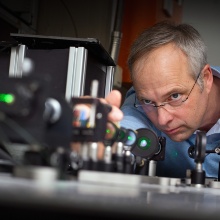For the second time already the European Research Council, ERC, is awarding the physicist, Professor Jörg Wrachtrup from the University of Stuttgart one of the renowned ERC “Advanced Investigator Grants“ for experienced excellent researchers. With the new grant, endowed with 2.5 million Euros, he wishes to show how it is possible to track electrical fields with to date unreached sensitivity and spatial resolution with quantum sensors.
The rector of the University of Stuttgart, Professor Wolfram Ressel, was delighted with this excellent success and commented: “In 2011 Professor Wrachtrup was one of the first scientists ever to be awarded an ERC grant. The fact that he is now receiving this high distinction for a second time confirms his outstanding scientific excellence as well as that of quantum technologies at the University of Stuttgart.”
The Baden-Württemberg Minster of Science, Theresia Bauer, also expressed her congratulations. “Universities in Baden-Württemberg and extramural research institutes have been successful in 12 cases of the current bidding round of the European Research Council. This is confirmation for us that in Baden-Württemberg the right brains are working on the right topics.“
Project: Illustration electrical fields of single molecular charges with quantum sensors
The research project going by the title of “Illustration of electrical fields of single molecular charges by means of quantum sensors“ follows on from the current research by Professor Wrachtrup on the use of atomic defects in diamonds for quantum technology.
For some time now it has been known that quantum sensors set new sensitivity records and that single protons, for example, can be “weighed”. However, up to now this was only possible under very special ambient conditions, for example in an ultra-high vacuum and at very low temperatures. As a result of the first ERC grant, the contents of which was the use of atomic defects in diamonds for quantum technology, Professor Wrachtrup and his team succeeded in also using these methods under ambient conditions. With this a multitude of applications fields, particularly in materials sciences and biomedical diagnostics, were developed.
Understanding how nerve cells work together
Some of these findings will now be continued and intensified in the framework of the new ERC grant. I wish to use this grant to show how it is possible with the aid of quantum sensors to track electrical fields with to date unachieved sensitivity and spatial resolution and with this to track, for example single electrical charges“, emphasised the scientist. In so doing Professor Wrachtrup wishes to pursue two application directions. “On the one hand we will investigate chemical, respectively biochemical reactions to the nanometre scale, even in very complex environments, such as for example in cells. With this we wish to track, among other things, the spatial dynamics of action potentials in nerve cells and understand through this how nerve cells work together in the brain, for example. On the other hand we will make precision measurements on the interaction of electrical charges and search for ‘new interactions‘, that could, for example, be responsible for the explanation of the dark matter in the universe.
Expert Contact:
Professor Dr. Jörg Wrachtrup, University of Stuttgart, 3rd Physics Institute Tel. 0711/685-65278, Email


